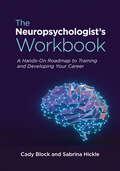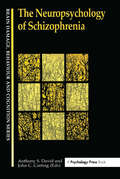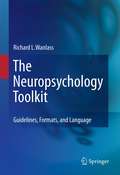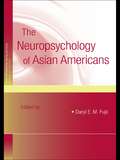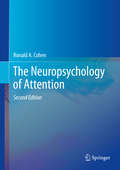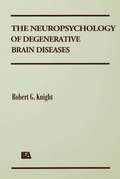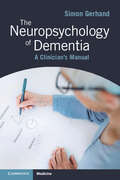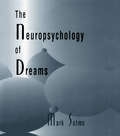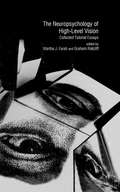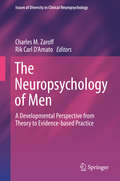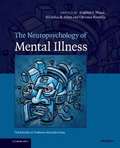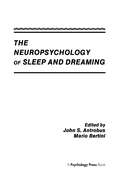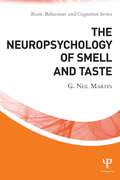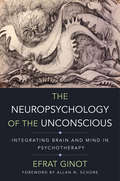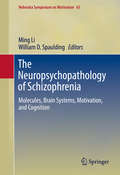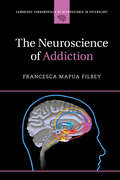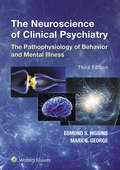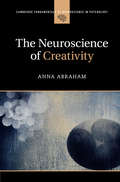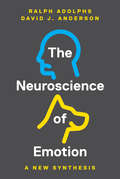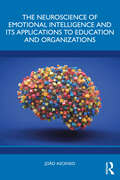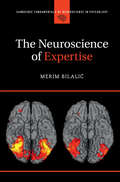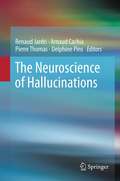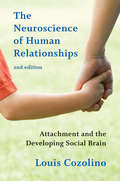- Table View
- List View
The Neuropsychologist's Workbook: A Hands-On Roadmap to Training and Developing Your Career
by Cady Block Sabrina Hickle PhDUnlock your career in neuropsychology with this practical workbook for aspiring professionals. This is a hands-on, practical workbook to accompany The Neuropsychologist&’s Roadmap: A Training and Career Guide. This workbook covers the training journey in neuropsychology, as well as its foundational and functional competencies. The workbook allows readers to access additional information, benefit from even more advice, and engage interactively with activities such as self-assessments, checklists, free writing exercises, and more. These activities help the reader reflect on and articulate personal values and goals to help guide them through their own journey. Using this workbook will help readers recognize their own strengths and weaknesses, so they know what they need to work on when considering the factors impacting entry into (and success within) graduate school, internship, fellowship, and the first job. This is a valuable resource for anyone considering a career in neuropsychology or those who train, supervisor, or mentor students in this field.
The Neuropsychology Of Schizophrenia (Brain, Behaviour and Cognition)
by Anthony S. David John C. CuttingSchizophrenia is being increasingly viewed as a neurological disorder. The Neuropsychology of Schizophrenia addresses the key questions in modern schizophrenia research. How do abnormalities of the brain produce the characteristic signs and symptoms of this most severe and mysterious mental malady? Where are these abnormalities? How do they develop? How can we detect them? What clinical and cognitive effects do they have? This new book is the first of its kind to tackle these questions in a systematic way from a number of allied perspectives: from phenomenology to physiology, animal behaviour to metacognition and from PET scans to paper and pencil tests. A number of authors from the United Kingdom and the United States have made contributions; all are acknowledged experts in the field. The chapters each contain a concise review of the particular topic, empirical data and also a theoretical overview. The Neuropsychology of Schizophrenia will be required reading for all serious students of schizophrenia from both medical and psychology backgrounds.
The Neuropsychology Toolkit
by Richard L. WanlassThis book provides information, guidelines, and materials to help future neuropsychology supervisees identify, understand, and avoid some of these problems and pitfalls. Also included are a neuropsychological questionnaire, short- and long-report formats, and sample statements that can be used to help with wording sections of the report that are particularly challenging to write.
The Neuropsychology of Asian Americans (Studies on Neuropsychology, Neurology and Cognition)
by Daryl E. M. FujiiThis volume is the first comprehensive resource to assist neuropsychologists to provide culturally competent services to Asian Americans. It highlights pertinent historical socio-cultural characteristics of the largest Asian American ethnic groups, which helps to conceptualize presentation, provide an optimal environment for test administration, interpret tests within a cultural context, and offer culturally sensitive feedback and recommendations. In addition, the volume gives a summary of the available neuropsychological literature for each Asian American ethnic group, recommendations for testing, and illustrative case samples. The second purpose of the volume is to provide a glimpse of how neuropsychology is currently practiced in different Asian countries, by reviewing the neuropsychological literature and by listing the available resources. This information gives valuable insights to neuropsychologists working with Asian communities throughout the world. Neuropsychology of Asian Americans is an essential resource for clinical neuropsychologists and school psychologists who perform neuropsychological services to Asians. It is also an important resource for academic neuropsychologists and students with Asians in their sample, as cultural variables may have moderating effects on data that information in this book helps to elucidate.
The Neuropsychology of Attention
by Ronald A. CohenIt has been 15 years since the original publication of Neuropsychology of Attention. At the time of its publication, attention was a construct that had long been of theoretical interest in the field of psychology and was receiving increased research by cognitive scientists. Yet, attention was typically viewed as a nuisance variable; a factor that needed to be accounted for when assessing brain function, but of limited importance in its own right. There is a need for a new edition of this book within Neuropsychology to present an updated and integrated review of what is know about attention, the disorders that affect it, and approaches to its clinical assessment and treatment. Such a book will provide perspectives for experimental neuropsychological study of attention and also provide clinicians with insights on how to approach this neuropsychological domain.
The Neuropsychology of Degenerative Brain Diseases
by Robert G. KnightThis volume utilizes various neurological diseases as its organizing principle, focusing specifically on their personal, social, and cognitive consequences. In so doing, it provides neuropsychologists, clinical psychologists, and those in related disciplines with an accessible survey of the available research on the psychological functioning of patients with the various disorders. Each chapter consists of a background review of the major features of one of the diseases, including symptom pattern, neuroanatomical bases, neuropathology, genetic factors, and epidemiology. Finally, the psychological and cognitive deficits established by research are reviewed, and their practical implications are discussed.
The Neuropsychology of Dementia: A Clinician's Manual
by Simon GerhandAn up-to-date clinical guide for healthcare professionals on the assessment, diagnosis and management of dementia and mild cognitive impairment (MCI), including the role played by neuropsychology in the diagnostic process. Written in an accessible style, it provides a reference book for qualified professionals and a valuable resource for students and trainees working in dementia services. The book covers the diagnosis and management of the most common forms of dementia, and some rarer types, and the latest advances in diagnostic technology and current and future treatment options. It explores non-pharmacological interventions for cognitive impairment and preventative measures to reduce the risk of developing dementia. Featuring the essential background information required by all clinicians working in the field, alongside a review of recent research and developments in the field. With an emphasis on the links between theory and practice, this is a must-read manual for clinicians working in memory clinics.
The Neuropsychology of Dreams: A Clinico-anatomical Study (Institute for Research in Behavioral Neuroscience Series)
by Mark SolmsIn this book, Mark Solms chronicles a fascinating effort to systematically apply the clinico-anatomical method to the study of dreams. The purpose of the effort was to place disorders of dreaming on an equivalent footing with those of other higher mental functions such as the aphasias, apraxias, and agnosias. Modern knowledge of the neurological organization of human mental functions was grounded upon systematic clinico-anatomical investigations of these functions under neuropathological conditions. It therefore seemed reasonable to assume that equivalent research into dreaming would provide analogous insights into the cerebral organization of this important but neglected function. Accordingly, the main thrust of the study was to identify changes in dreaming that are systematically associated with focal cerebral pathology and to describe the clinical and anatomical characteristics of those changes. The goal, in short, was to establish a nosology of dream disorders with neuropathological significance. Unless dreaming turned out to be organized in a fundamentally different way than other mental functions, there was every reason to expect that this research would cast light on the cerebral organization of the normal dream process.
The Neuropsychology of Face Perception and Facial Expression (Neuropsychology and Neurolinguistics Series)
by Raymond BruyerThis book is the first to offer an overview of the increasingly studied field of face perception. Experimental and pathological dissociation methods are used to understand both the precise cognitive mechanisms and the cerebral functions involved in face perception. Three main areas of investigation are discussed: face processing after brain damage; lateral differences for face processing in normals; neuropsychological studies on facial expressions.
The Neuropsychology of High-level Vision: Collected Tutorial Essays (Carnegie Mellon Symposia on Cognition Series)
by Martha J. Farah Graham RatcliffThis book provides a state-of-the-art review of high-level vision and the brain. Topics covered include object representation and recognition, category-specific visual knowledge, perceptual processes in reading, top-down processes in vision -- including attention and mental imagery -- and the relations between vision and conscious awareness. Each chapter includes a tutorial overview emphasizing the current state of knowledge and outstanding theoretical issues in the authors' area of research, along with a more in-depth report of an illustrative research project in the same area. The editors and contributors to this volume are among the most respected figures in the field of neuropsychology and perception, making the work presented here a standard-setting text and reference in that area.
The Neuropsychology of Men
by Rik Carl D'Amato Charles M. ZaroffThis timely text examines normative and pathological brain/behavior connections across the male lifespan, and how these findings can best inform research, intervention, and prevention. It spotlights possible etiologies for male-dominated pathology, including academic deficits and disorders relating to violence, as well as identifying men's psychological resilience and vulnerabilities throughout life. Clinical and social issues are intricately linked here, particularly in areas such as substance abuse, emotion processing, and sequelae of brain trauma. In these ways, the text moves on from the simplistic view of males as the standard in psychological studies while respecting complicated questions about biology and environment that have yet to be resolved. Since the inception of psychology, much research has focused specifically on men but few studies have offered distinctive interventions developed to help this unique male population. This volume fills the chasm left from many seminal studies. Among the featured topics: · Imaging and development: relevant findings in males. · Understanding the neuropsychology of autism spectrum disorders in men. · Understanding disorders of defiance, aggression, and violence in males. · Serving men with traumatic brain injuries. · Men at risk: special education and incarceration. · The neuropsychological basis of emotion and social cognition in men. The Neuropsychology of Men offers neuropsychologists, clinical psychologists, and rehabilitation specialists an evidence-based framework for understanding male-specific cognitive and behavioral trends in the normative population, and for identifying and addressing challenges in boys and men outside the norm.
The Neuropsychology of Mental Illness
by Stephen J. Wood Nicholas B. Allen Christos PantelisIt is widely accepted that most psychiatric disorders are associated with cognitive impairment and that neuropsychological approaches can help unravel the mechanisms underlying brain function and help us develop a better understanding of these disorders. In this book, a panel of the world's leading experts describe the development of neuropsychological approaches to the investigation, description, measurement and management of a wide range of mental illnesses. Part One explains the rationale for examining neuropsychological processes within clinical disorders, leading into Part Two summarizing and critiquing the methodological approaches to study. Part Three covers each of the major psychiatric disorders and provides a summary of the neuropsychological findings for each condition. The final section brings together the perspectives of neuroscientists, psychiatrists and philosophers. Essential reading for all those studying the healthy as well as the disordered brain, The Neuropsychology of Mental Illness will appeal to specialists from the fields of mental health, psychology, clinical neuroscience and philosophy.
The Neuropsychology of Sleep and Dreaming
by John S. Antrobus Mario BertiniThis volume describes how the conceptual and technical sophistication of contemporary cognitive and neuroscientific fields has enhanced the neurocognitive understanding of dreaming sleep. Because it is the only naturally-occurring state in which the active brain produces elaborate cognitive processes in the absence of sensory input, the study of dreaming offers a unique cognitive and neurophysiological view of the production of higher cognitive processes. The theory and research included is driven by the search for the most direct relationships linking the neurophysiological characteristics of sleepers to their concurrent cognitive experiences. The search is organized around three sets of theoretical models and the three classes of neurocognitive relationships upon which they are based. The contributions to this volume demonstrate that the field has begun to move in new directions opened up by the rapid advances in contemporary cognitive science, neuropsychology, and neurophysiology.
The Neuropsychology of Smell and Taste (Brain, Behaviour and Cognition)
by G. Neil MartinSmell and taste are our most misunderstood senses. Given a choice between losing our sense of smell and taste, or our senses of sight and hearing, most people nominate the former, rather than the latter. Yet our sense of smell and taste has the power to stir up memories, alter our mood and even influence our behaviour. In The Neuropsychology of Smell and Taste, Neil Martin provides a comprehensive, critical analysis of the role of the brain in gustation and olfaction. In his accessible and characteristic style he shows why our sense of smell and taste do not simply perform basic and intermittent functions, but lie at the very centre of our perception of the world around us. Through an exploration of the physiology, anatomy and neuropsychology of the senses; the neurophysiological causes of smell and taste disorders, and their function in physical and mental illness, Neil Martin provides an accessible and up-to-date overview of the processes of gustation and olfaction. The Neuropsychology of Smell and Taste provides a state-of-the-art overview of current research in olfactory and gustatory perception. With sections describing the effect of odour and taste on our behaviour, and evaluating the contribution current neuroimaging technology has made to our understanding of the senses, the book will be of interest to researchers and students of neuropsychology and neuroscience, and anybody with an interest in olfaction and gustation.
The Neuropsychology of the Unconscious: Integrating Brain and Mind in Psychotherapy (Norton Series on Interpersonal Neurobiology)
by Allan N. Schore Efrat GinotA scientific take on the still-central therapeutic concept of "the unconscious." More than one hundred years after Freud began publishing some of his seminal theories, the concept of the unconscious still occupies a central position in many theoretical frameworks and clinical approaches. When trying to understand clients' internal and interpersonal struggles it is almost inconceivable not to look for unconscious motivation, conflicts, and relational patterns. Clinicians also consider it a breakthrough to recognize how our own unconscious patterns have interacted with those of our clients. Although clinicians use concepts such as the unconscious and dissociation, in actuality many do not take into account the newly emerging neuropsychological attributes of nonconscious processes. As a result, assumptions and lack of clarity overtake information that can become central in our clinical work. This revolutionary book presents a new model of the unconscious, one that is continuing to emerge from the integration of neuropsychological research with clinical experience. Drawing from clinical observations of specific therapeutic cases, affect theory, research into cognitive neuroscience and neuropsychological findings, the book presents an expanded picture of nonconscious processes. The model moves from a focus on dissociated affects, behaviors, memories, and the fantasies that are unconsciously created, to viewing unconscious as giving expression to whole patterns of feeling, thinking and behaving, patterns that are so integrated and entrenched as to make them our personality traits. Topics covered include: the centrality of subcortical regions, automaticity, repetition, and biased memory systems; role of the amygdala and its sensitivity to fears in shaping and coloring unconscious self-systems; self-narratives; therapeutic enactments; therapeutic resistance; defensive systems and narcissism; therapeutic approaches designed to utilize some of the new understandings regarding unconscious processes and their interaction with higher level conscious ones embedded in the prefrontal cortex.
The Neuropsychopathology of Schizophrenia
by Ming Li William D. SpauldingOneof the first major theoretical reviews of schizophrenia since the publicationof the 5th edition of the APA's Diagnostic and Statistical Manual, the DSM-5, thisvolume is a landmark in the history of schizophrenia research. It assembles recentgroundbreaking developments in research on schizophrenia and reaffirms itscentral place in the mental health research agenda. Significantly, this volumereflects theparadigmatic shift in schizophrenia research applied in parallel to newapproaches in psychiatric diagnosis. New models and findingsfrom across disciplines in recent years reflect a new and greater understandingof the workings of the brain, which, in turn, helps develop our knowledge ofthe neuro and psychological processes in schizophrenia. Consequently, thisvolume illustrates a historicalconvergence of psychology, psychopathology and the neurosciences inschizophrenia. World-renownedleaders of theschizophrenia research community in fields such as neuroscience,psychiatry, neuropsychology, and clinical psychology offer clear suggestionsfor further advances in psychological and medical interventions, assessment, preventionstrategies, and research. And in keeping with other titles in the NebraskaSymposium on Motivation series, these papers are noteworthy for their depth ofdetail, scientific rigor, and clinical relevance. Includedamong the topics: Cognitive organization as a dimension of individual differences and psychopathology. Neurodevelopmental genomic strategies in the study of the psychosis spectrum. Multimodal brain and behavior indices of psychosis risk. The NIMH Research Domain Criteria Project: new approaches to classifying psychotic spectrum disorders. The Neuropsychopathology of Schizophrenia is one of the mostforward-thinking and engaging treatments of the field in recent years, and isan indispensable text for all researchers, academics, and clinicians who treator study mental illness, especially psychiatrists, psychologists, mental healthpractitioners, and neuroscientists specializing in schizophrenia.
The Neuroscience of Addiction (Cambridge Fundamentals of Neuroscience in Psychology)
by Francesca Mapua FilbeyThis book addresses a growing need for accessible information on the neuroscience of addiction. In the past decade, neuroscientific research has greatly advanced our understanding of the brain mechanisms of addiction. However this information still remains largely confined to scientific outlets. As legislation continues to evolve and the stigma surrounding addiction persists, new findings on the impact of substances on the brain are an important public health issue. Francesca Mapua Filbey gives readers an overview of research on addiction including classic theories as well as current neuroscientific studies. A variety of textual supports - including a glossary, learning objectives and review questions - help students better reinforce their reading and make the text a ready-made complement to undergraduate and graduate courses on addiction.
The Neuroscience of Clinical Psychiatry: The Pathophysiology Of Behavior And Mental Illness
by Edmund HigginsBridge the gap between neuroscience and mental illness/mental health with this straightforward and reader-friendly resource! The Neuroscience of Clinical Psychiatry, 3rd Edition is a highly readable, in-depth text ideal for residents studying for boards, practicing psychiatrists, and any mental health professional seeking an overview of the neuroscience revolution. Focusing on the basic neuroscientific concepts underlying normal behavior and commonly encountered disorders, Dr. Edmund S. Higgins and Dr. Mark S. George make complex information enjoyable, relevant, and easy to understand, ensuring that this Third Edition continues to be a trusted source of information on the neurologic underpinnings of psychiatric disorders.
The Neuroscience of Creativity (Cambridge Fundamentals of Neuroscience in Psychology)
by Anna AbrahamWhat happens in our brains when we compose a melody, write a poem, paint a picture, or choreograph a dance sequence? How is this different from what occurs in the brain when we generate a new theory or a scientific hypothesis? In this book, Anna Abraham reveals how the tools of neuroscience can be employed to uncover the answers to these and other vital questions. She explores the intricate workings of our creative minds to explain what happens in our brains when we operate in a creative mode versus an uncreative mode. The vast and complex field that is the neuroscience of creativity is disentangled and described in an accessible manner, balancing what is known so far with critical issues that are as yet unresolved. Clear guidelines are also provided for researchers who pursue the big questions in their bid to discover the creative mind.
The Neuroscience of Emotion: A New Synthesis
by David Anderson Ralph AdolphsA new framework for the neuroscientific study of emotions in humans and animalsThe Neuroscience of Emotion presents a new framework for the neuroscientific study of emotion across species. Written by Ralph Adolphs and David J. Anderson, two leading authorities on the study of emotion, this accessible and original book recasts the discipline and demonstrates that in order to understand emotion, we need to examine its biological roots in humans and animals. Only through a comparative approach that encompasses work at the molecular, cellular, systems, and cognitive levels will we be able to comprehend what emotions do, how they evolved, how the brain shapes their development, and even how we might engineer them into robots in the future. Showing that emotions are ubiquitous across species and implemented in specific brain circuits, Adolphs and Anderson offer a broad foundation for thinking about emotions as evolved, functionally defined biological states. The authors discuss the techniques and findings from modern neuroscientific investigations of emotion and conclude with a survey of theories and future research directions. Featuring color illustrations throughout, The Neuroscience of Emotion synthesizes the latest in neuroscientific work to provide deeper insights into how emotions function in all of us.
The Neuroscience of Emotional Intelligence and Its Applications to Education and Organizations
by João AscensoThis book provides a clear understanding of the neuromechanisms of emotional intelligence and its applications to education and organizations through practical exercises.Divided into three parts, the book begins by explaining the data that help us understand the neural mechanisms of emotional intelligence. Part 2 focuses on application in educational contexts by presenting emotional intelligence education programs for children and adolescents as well as an analysis of emotional intelligence from a practical point of view. Part 3 switches the focus to organizations through the leadership with emotional and social intelligence model as proposed and validated by Daniel Goleman and Richard Boyatzis. Both parts offer a series of practical and engaging exercises for application to adolescents, children and educators, and organizational environments respectively. Presented simply, the book gives a scientifically rigorous and structured overview of how neuroscience has helped in understanding the neural mechanisms of emotions and its applications.It is indispensable reading for neuroscientists, psychologists, leaders, managers, teachers, and educators, and all those interested in the search for personal and professional success.
The Neuroscience of Expertise (Cambridge Fundamentals of Neuroscience in Psychology)
by Merim BilalićThe Neuroscience of Expertise examines the ways in which the brain accommodates the incredible feats of experts. It builds on a tradition of cognitive research to explain how the processes of perception, attention, and memory come together to enable experts' outstanding performance. The text explains how the brain adapts to enable the complex cognitive machinery behind expertise, and provides a unifying framework to illuminate the seemingly unconnected performance of experts in different domains. Whether it is a radiologist who must spot a pathology in a split second, a chess grandmaster who finds the right path in a jungle of possible continuations, or a tennis professional who reacts impossibly quickly to return a serve, The Neuroscience of Expertise offers insight into the universal cognitive and neural mechanisms behind these achievements.
The Neuroscience of Freedom and Creativity
by Joaquín M. FusterProfessor Joaquín M. Fuster is an eminent cognitive neuroscientist whose research over the last five decades has made fundamental contributions to our understanding of the neural structures underlying cognition and behaviour. This book provides his view on the eternal question of whether we have free will. Based on his seminal work on the functions of the prefrontal cortex in decision-making, planning, creativity, working memory, and language, Professor Fuster argues that the liberty or freedom to choose between alternatives is a function of the cerebral cortex, under prefrontal control, in its reciprocal interaction with the environment. Freedom is therefore inseparable from that circular relationship. 'The Neuroscience of Freedom and Creativity' is a fascinating inquiry into the cerebral foundation of our ability to choose between alternative actions and to freely lead creative plans to their goal.
The Neuroscience of Hallucinations
by Delphine Pins Pierre Thomas Renaud Jardri Arnaud CachiaHallucinatory phenomena have held the fascination of science since the dawn of medicine, and the popular imagination from the beginning of recorded history. Their study has become a critical aspect of our knowledge of the brain, making significant strides in recent years with advances in neuroimaging, and has established common ground among what normally are regarded as disparate fields. The Neuroscience of Hallucinations synthesizes the most up-to-date findings on these intriguing auditory, visual, olfactory, gustatory, and somatosensory experiences, from their molecular origins to their cognitive expression. In recognition of the wide audience for this information among the neuroscientific, medical, and psychology communities, its editors bring a mature evidence base to highly subjective experience. This knowledge is presented in comprehensive detail as leading researchers across the disciplines ground readers in the basics, offer current cognitive, neurobiological, and computational models of hallucinations, analyze the latest neuroimaging technologies, and discuss emerging interventions, including neuromodulation therapies, new antipsychotic drugs, and integrative programs. Among the topics covered: Hallucinations in the healthy individual. A pathophysiology of transdiagnostic hallucinations including computational and connectivity modeling. Molecular mechanisms of hallucinogenic drugs. Structural and functional variations in the hallucinatory brain in schizophrenia. The neurodevelopment of hallucinations. Innovations in brain stimulation techniques and imaging-guided therapy. Psychiatrists, neurologists, neuropsychologists, cognitive neuroscientists, clinical psychologists, and pharmacologists will welcome The Neuroscience of Hallucinations as a vital guide to the current state and promising future of their shared field.
The Neuroscience of Human Relationships: Attachment and the Developing Social Brain (Second Edition) (Norton Series on Interpersonal Neurobiology) (Norton Series on Interpersonal Neurobiology #0)
by Louis CozolinoA revised edition of the best-selling text on how relationships build our brains. As human beings, we cherish our individuality yet we know that we live in constant relationship to others, and that other people play a significant part in regulating our emotional and social behavior. Although this interdependence is a reality of our existence, we are just beginning to understand that we have evolved as social creatures with interwoven brains and biologies. The human brain itself is a social organ and to truly understand being human, we must understand not only how we as whole people exist with others, but how our brains, themselves, exist in relationship to other brains. The first edition of this book tackled these important questions of interpersonal neurobiology--that the brain is a social organ built through experience--using poignant case examples from the author's years of clinical experience. Brain drawings and elegant explanations of social neuroscience wove together emerging findings from the research literature to bring neuroscience to the stories of our lives. Since the publication of the first edition in 2006, the field of social neuroscience has grown at a mind-numbing pace. Technical advances now provide more windows into our inner neural universe and terms like attachment, empathy, compassion, and mindfulness have begun to appear in the scientific literature. Overall, there has been a deepening appreciation for the essential interdependence of brain and mind. More and more parents, teachers, and therapists are asking how brains develop, grow, connect, learn, and heal. The new edition of this book organizes this cutting-edge, abundant research and presents its compelling insights, reflecting a host of significant developments in social neuroscience. Our understanding of mirror neurons and their significance to human relationships has continued to expand and deepen and is discussed here. Additionally, this edition reflects the gradual shift in focus from individual brain structures to functional neural systems--an important and necessary step forward. A great deal of neural overlap has been discovered in brain activation when we are thinking about others and ourselves. This raises many questions including how we come to know others and whether the notion of an "individual self" is anything more than an evolutionary strategy to support our interconnection. In short, we are just beginning to see the larger implications of all neurological processes--how the architecture of the brain can help us to better understand individuals and our relationships. This book gives readers a deeper appreciation of how and why relationships have the power to reshape our brains throughout our life.
